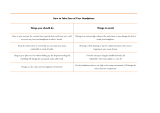
i
Tab 3, 11
Tab 8, 16 Tab 7, 15 Tab 6, 14 Tab 5, 13 Tab 4, 12
EnglishTab2 , 1 0
SAFETY INFORMATION
NOTE: This equipment has been tested and
found to comply with the limits for a Class B
digital device, pursuant to Part 15 of the
FCC Rules. These limits are designed to
provide reasonable protection against
harmful interference in a residential
installation. This equipment generates, uses,
and can radiate radio frequency energy and,
if not installed and used in accordance with
the instructions, may cause harmful
interference to radio communications.
However, there is no guarantee that
interference will not occur in a particular
installation. If this equipment does cause
harmful interference to radio or television
reception, which can be determined by
turning this equipment off and on, the user is
encouraged to try to correct the interference
by one or more of the following measures:
– Re-orient or relocate the receiving
antenna.
– Increase the separation between this
equipment and receiver.
– Connect this equipment into an outlet on
a circuit different from that to which the
receiver is connected.
– Consult Bose or an experienced radio/TV
technician for help.
Changes or modifications not expressly
approved by Bose Corporation could void
the user’s authority to operate this
equipment.
Operation is subject to the following two
conditions: (1) This device may not cause
harmful interference, and (2) this device
must accept any interference received,
including interference that may cause
undesired operation.
This device complies with FCC and Industry
Canada RF radiation exposure limits for
general population. It must not be collocated
or operating in conjunction with any other
antenna or transmitter.
Bose Corporation hereby declares
that this product is in compliance
with the essential requirements
and other relevant provisions of
Directive 1999/5/EC and all other
applicable EU directive
requirements. The complete
declaration of conformity
can be found at:
www.Bose.com/compliance.
Operate this product within the temperature
range of 5°F to 131°F (-15°C to 55°C) only.
Important Safety Instructions
• Please read these instructions carefully
and completely before using the headset.
• Keep these instructions and make these
instructions easily accessible to all users
at all times. Always include these
instructions when passing the headset
on to third parties.
• During flight operations, do not use the
headset for telephone calls.
• It is the responsibility of each aircraft
operator or pilot in command to
determine that any and all portable
devices will be free of any interference
with the navigation or communication
system of the aircraft. In addition, it is
their responsibility to determine the
suitability of the performance of portable
devices in relation to the use of the
Bose
®
A20
®
Aviation Headset.
• The headset is capable of producing
sound pressure levels exceeding
85dB(A). In many countries 85dB(A) is
the maximum legally permissible level for
continuous noise exposure during the
working day. Exposure to sounds of
higher volume levels or longer durations
can permanently damage your hearing.
• Never repair or attempt to repair a
defective headset yourself. Contact
Bose
®
Technical Support. Refer to
“Contact information” on page 37.
• Do not immerse the headphones in water
or any other liquid. See “Cleaning the
headset” on page 23 for cleaning
instructions.
• Warning: Choking
hazard. Keep the
batteries away from
children.
• Danger of explosion if
batteries are incorrectly replaced.
Replace only with AA alkaline
batteries. Do not use any other
battery chemistries.
Batteries may cause a fire or chemical
burn if mishandled. Do not recharge,
disassemble, heat, or incinerate.
Dispose of used batteries properly.
00_Cavu.book Page i Wednesday, April 25, 2012 10:10 AM
























